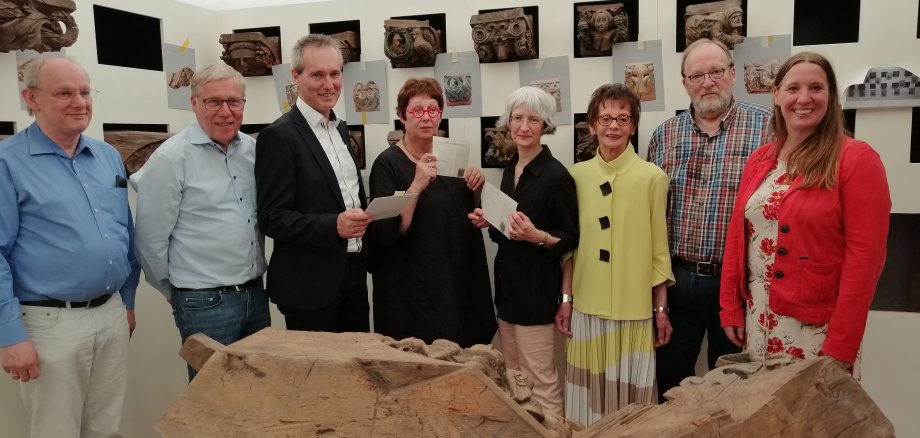Museum in Frankenberg Monastery gets new exhibition concept
The former monastery building in Frankenberg has already been the seat of nuns, an alternative location for the Philipps University of Marburg in times of plague or a district court with a prison. Today, it houses the administrative office of the Waldeck-Frankenberg district with its own museum, which has been undergoing extensive reconstruction since mid-2022 according to a new concept. Around half a million euros (approx. 438,000 euros) will be invested here, financed by the state of Hesse and the district of Waldeck-Frankenberg and additionally supported by the Philipp Soldan Society and the town of Frankenberg (Eder).
After completion, the museum will invite visitors to travel through the centuries in the town and old district of Frankenberg on two floors under the title "Frankenberg an der Eder - Stadteinsichten und Kreisausblicke". In the refectory, the lower exhibition room, the theme is the life and images of the town of Frankenberg from the 14th to the 16th century. In the Dormitory, the upper exhibition room, the focus will be on the world of life in the agrarian town and the rural old district of Frankenberg. The departments will be linked by a "time window". For example, traditional costumes will be juxtaposed with today's fashion, the former use of water power with the mills with today's electrification, or the town planning of the Middle Ages with modern town planning and redevelopment.
The reorganisation of the museum has so far taken place in two steps. After the development of a framework concept, the historians Kirsten Hauer M. A. and Friedhelm Krause M. A. drew up the detailed concept in 2022. A. developed the detailed concept. Under the leadership of museum director Dr Birgit Kümmel and supported by museum employee Ruth Piro-Klein, the first construction phase was realised, which spatially concerns the foyer, the cloister wing and the refectory of the former monastery building.
The following themes will be implemented in the 1st construction phase: The Museum in Frankenberg Monastery - The Philipp Soldan Town - The Town on Frankenberg - The Cistercian Nuns of Georgenberg - The Power Struggle of the Nuns - The Colonists in Friedrichshausen - Soldan - From the Region into the World - Printed Inspiration - The Tangible Technique of the "Formensnider zum Frankenbergk" - A Town Plan - Yesterday and Today - Frankenberg Blossoms and Burns - Lady Chapel and Tyle Figures - Reconstruction in the Humanist Wedding and Renaissance - Illustrious Contemporaries - The Frankenberg Humanists - New Times - The Reformation - Philipp Soldan - Pictorial Creation in Humanism and Reformation - Frankenberg Heads anno 1529 - The Frankenberg Town Hall - The Philipp Stone in Haina - Soldan's Work in the Region - The Huguenot Settlement of Louisendorf. Here, important and nationally outstanding exhibits from the furnishings of the Liebfrauenkirche are preserved, which are among the treasures of the museum's holdings.
In a second construction phase, the departments on the history of the town and district of Frankenberg are now being dealt with. Theme islands are being created and the numerous exhibits are being presented according to current standards. In addition to explanations through text panels, media stations are also being developed to convey the object history and context. In spatial terms, this construction phase concerns the dormitory of the former monastery building.
The following themes will be implemented in the 2nd construction phase: 1821: Frankenberg becomes a district - 1821: The centre of the district - Frankenberg's backbone: textile production - The Niedermühle: water art and power generation - Of living together in the Shoah - The fate of Frankenberger Jacob Katzenstein (1865-1943) - Times of hardship and National Socialism - The fate of Frankenberger Karl Richter (1907-1944) - 1933/45 - 1968 - The doctor August Loderhose and "the 68ers" - The small-town German - Association involvement: Of cyclists, role models and the march to the Listenbach - Mining: Frankenberg, Geismar, Thalitter - Traditional costumes in the district - Fashionable hats in the city - Hessenstein Castle - Ruin of Keseburg - Failed in the bourgeoisie: The WAA
The focus is particularly on Frankenberg's heyday - and here especially on the works of the Frankenberg woodcarvers and stone sculptors Philipp Soldan and Tyle von Frankenberg. In addition to numerous objects that show how the region around the monastery developed over the centuries, the museum in the monastery will in future use interactive media stations that convey the history of the objects and the context, as well as explanatory text panels.
The new concept and the reconstruction, which started in mid-2022 and is expected to be completed by the end of 2024, will cost a total of 438,000 euros. The state of Hesse will pay about 277,000 euros (276,900 euros), the district of Waldeck-Frankenberg will invest about 150,000 euros (149,100 euros). The district received a grant of 10,000 euros each from the Philipp-Soldan-Gesellschaft (formerly Förderverein Kreisheimatmuseum) and the town of Frankenberg (Eder). The funds will be used for the new conception of the former local history museum, for planning and design, scientific support and the conversion. Further information is also available online at www.landkreis-waldeck-frankenberg.de, search term "Museum im Kloster".
Keywords:
Experience Culture Museum in the Cistercian Monastery St. Georgenberg
